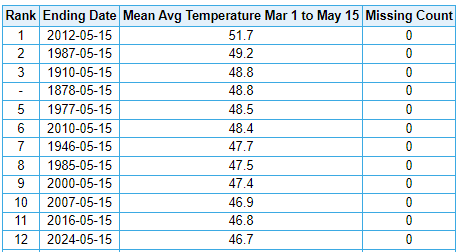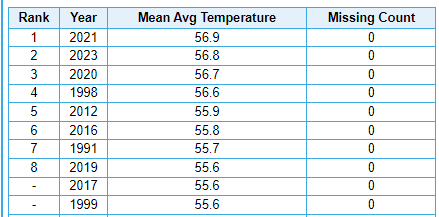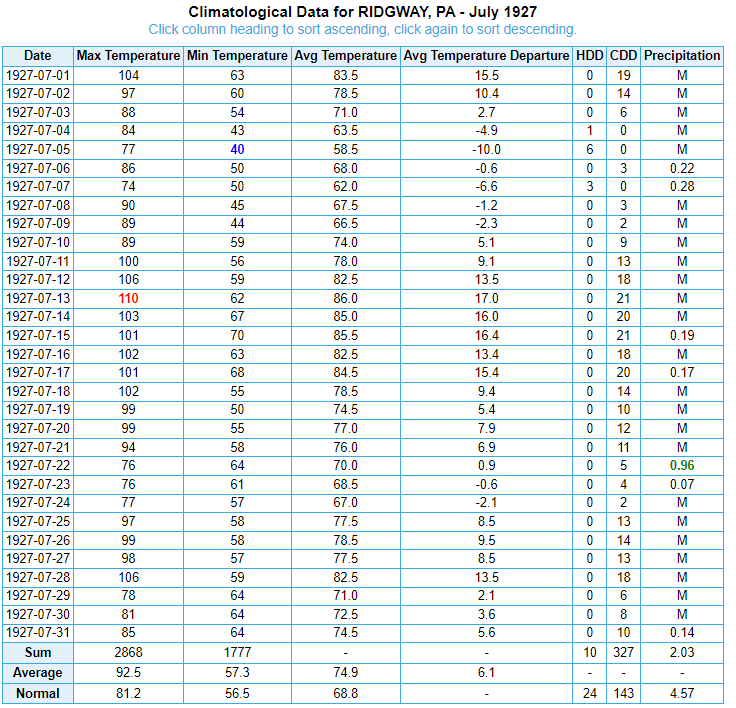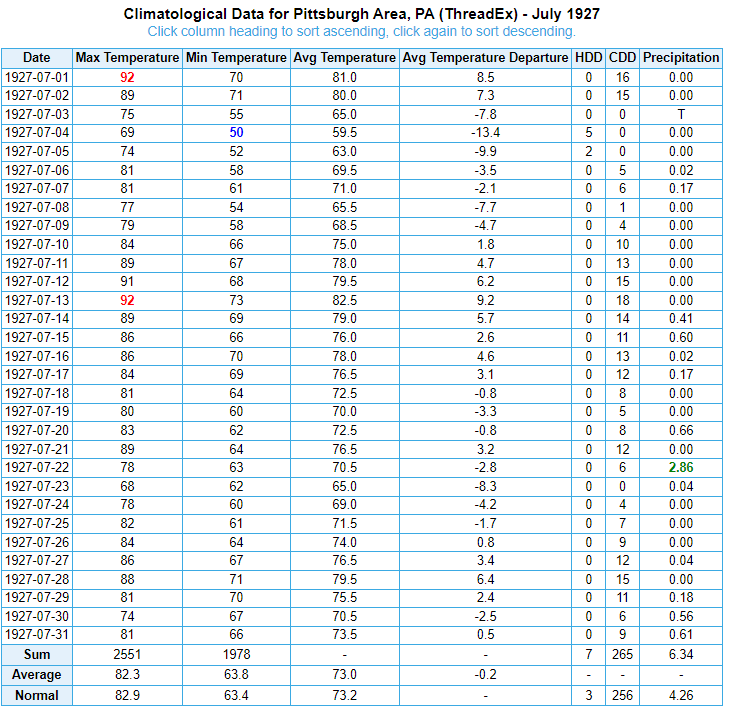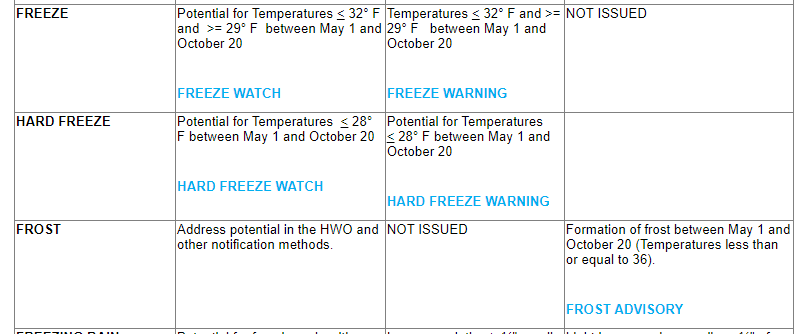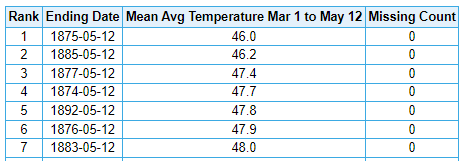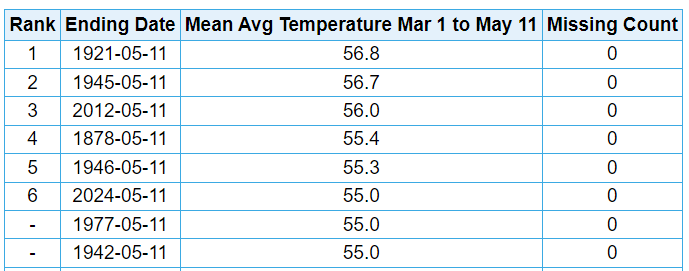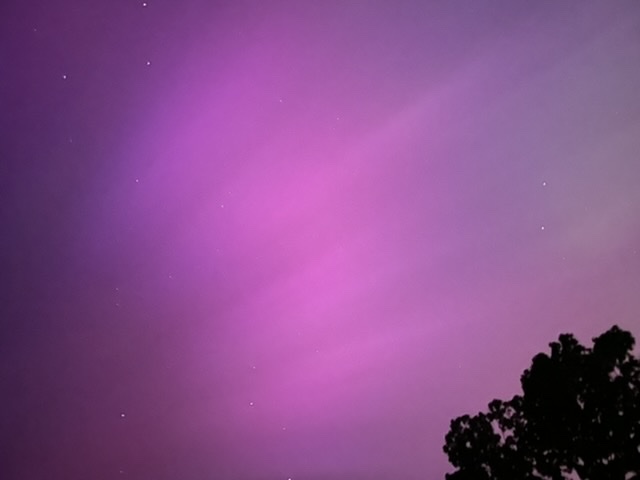
TheClimateChanger
Members-
Posts
4,043 -
Joined
-
Last visited
Content Type
Profiles
Blogs
Forums
American Weather
Media Demo
Store
Gallery
Everything posted by TheClimateChanger
-
Central Pa. Spring 2024
TheClimateChanger replied to mahantango#1's topic in Upstate New York/Pennsylvania
Looks like those are based primarily off CXY, which makes sense since it used to be the official station in Harrisburg. MDT is about a degree or so cooler. It's a trick NOAA does to hide the warming. Repeatedly switch the "official" station to ever cooler locations to mask some of the warming trend. From a downtown windowsill to a downtown rooftop to an urban airport on the outskirts of town and then to a much larger airport in a rural-suburban area either surrounded by water or at a higher elevation, and then thread them all together! Also to hide even more warming switch the data source from a warmer LiG thermometer housed in CRS to an automated weather station (MMTS/ASOS). And then have trolls complain about any adjustments that are made. -
May 2024 General Discussion
TheClimateChanger replied to HillsdaleMIWeather's topic in Lakes/Ohio Valley
Not bad, but 2012 saw a much warmer spring in most locations. Data below are for the period 3/1 to 5/15. Second warmest in most places in the southern parts of the subforum [1977 was warmer at ORD & DSM], but not as warm in the north. Only 12th mildest at MSP. MKE ORD DSM DTW TOL IND CMH CLE MSP -
It sounds like Dr. Hansen believes this is the peak of this El Niño cycle. Although it’s not all good news, as he also thinks we have surpassed 1.5C for all practical purposes.
-
Central Pa. Spring 2024
TheClimateChanger replied to mahantango#1's topic in Upstate New York/Pennsylvania
They must be manipulating the raw data out of the MDT ASOS because almost every recent year has been record warm. -
Central Pa. Spring 2024
TheClimateChanger replied to mahantango#1's topic in Upstate New York/Pennsylvania
Through May 15, the mean temperature at Harrisburg International Airport (MDT) is currently 45.8F, good for 4th warmest YTD in the threaded records behind 2023, 1998 & 2012. Turning to the top 10 for the full year, 2021 is number one, followed by 2023 and 2020. To date, MDT is running 1.7F warmer than 2021, 1.3F warmer than 2020 and 0.8F cooler than 2023. Could make a run for warmest year on record this year (dating to 1889). -
Occasional Thoughts on Climate Change
TheClimateChanger replied to donsutherland1's topic in Climate Change
-
Occasional Thoughts on Climate Change
TheClimateChanger replied to donsutherland1's topic in Climate Change
-
Occasional Thoughts on Climate Change
TheClimateChanger replied to donsutherland1's topic in Climate Change
Man, this guy has no shame. Imagine claiming the state record for 95+ days is in a small town nestled in the northern Pennsylvania mountains. Not Philadelphia or one of the surrounding lower elevation sites, but a tiny, tiny hamlet at 1400' surrounded by 2000'+ ridges. Let's take a look at this data from 1927. For comparison, here is downtown Pittsburgh for the same month. Ridgway is typically 4 or 5 degrees cooler than Pittsburgh [particularly downtown]. It's not an exaggeration to say these high temperatures [which are quite obviously taken from an instrument that would have been exposed to direct sunlight] are 15-20 degrees too high. Actually, anyone with half a brain should be able to see it's actually proof of just how much it's warmed since then. 1927 - despite absurdly unrepresentative summertime high temperatures which are clearly 15-20 degrees too high most days - is only about a degree or so warmer than many recent years on the annual mean! And that is without any of the much-maligned adjustments for Time of Observation [was 5:30 p.m. in 1927] or change in instrumentation [MMTS]. -
Pittsburgh/Western PA Spring 2024
TheClimateChanger replied to Ahoff's topic in Upstate New York/Pennsylvania
Well May hasn't been too remarkable, but with about two weeks left, we are currently in second place for warmest springs in the threaded Pittsburgh area record. Coming off the heels of the fourth warmest winter. -
Occasional Thoughts on Climate Change
TheClimateChanger replied to donsutherland1's topic in Climate Change
The NWS has also quietly changed the frost and freeze criteria. All of those frost and freeze advisories and warnings that were near constant through April [and have been common in recent years] would NOT have been issued in past decades because the growing season was not considered to have begun by that point in these areas. A lot of NWS offices now just use the amorphous phrase "during the growing season" but there is still some residual evidence of the traditional criteria. You see all the frost and freeze warnings, and think "wow, it must be cold this spring. Never seen so many frost warnings." BUT that's because these events would have all been unwarned in the past. Here's the traditional criteria for some NWS offices: CTP The traditional growing season [and issuance of frost/freeze products] does not start until May 21 in the northwest mountains and would have just begun May 11 in the second tier of counties. There were numerous frost/freeze products issued in April in these areas. IWX Source: Northern Indiana Watch, Warning and Advisory Criteria (weather.gov) Note - issued only between May 1 and October 20, yet these products were issued numerous times by IWX this April. -
Occasional Thoughts on Climate Change
TheClimateChanger replied to donsutherland1's topic in Climate Change
Most of this is not due to any sort of "strange disconnect" but due to people's perception of what is normal being warped. It used to be perfectly normal for Lake Erie to be covered in ice (or at least substantial ice coverage) at Buffalo, New York, well into May. This year, the water temperature is 52F, one shy of the record for the date set in 2012 & 2000. Source: Lake Erie May Temperatures Buffalo (weather.gov) Just scanning through this, you can see ice [as signified by underlying water at the freezing point] was present through at least May 10, 1928; May 1, 1930; May 16, 1936; May 6, 1939; May 10, 1940; May 12, 1943; May 15, 1947 [thermometer appears to be reading 1F warm this year]; May 9, 1959; May 11, 1963; May 12, 1965; May 23, 1971; May 2, 1972; May 12, 1978; May 7, 1982; May 2, 1996; and May 1, 2014. In this data, we can see the first shift to a new climate regime following the 1982-1983 Super El Nino event. While prior to that El Nino event, ice was commonplace in the month of May, it is now exceptionally rare. Ice past the middle of May, as occurred in 1936 & 1971, is almost unfathomable today. I mean 2014 was regarded as exceptionally cold, but came nowhere near reproducing that effect. We can substantial ice was present on the east end of Lake Erie deep into May 1936, while some icebergs remained through May 31, 1936. This during the so-called hottest summer on record. Funny how we're told how hot it was in the 1930s & 1940s, yet that heat doesn't show up in water. -
Occasional Thoughts on Climate Change
TheClimateChanger replied to donsutherland1's topic in Climate Change
Here is one recent example of Tony cherry-picking 1921. My question if millions died in 1921's "record heat wave" and every recent year has been much hotter, how many tens of millions of climate deaths are they hiding each and every year? One might say "air conditioning" but many of the world's poorest regions are some of the hottest places on earth, and the global population has exploded since then. There must be tens of millions of deaths being swept under the table or the 1921 reporting was incorrect. -
Occasional Thoughts on Climate Change
TheClimateChanger replied to donsutherland1's topic in Climate Change
Looking at the data, the only pre-21st century year with a similar spring appears to be 1921. I always laugh when Tony Heller posts stories from 1921 - he does it very frequently. I don't know what point he is trying to make. Pretty much every year is as warm or warmer than 1921 these days. The same weather in 2024 would probably be dismissed as chilly. Yet back then it was enough to do multiple page spreads about the "millions of heat deaths." By the same standard, every single year needs to have multiple spreads of coverage in the 21st century. But our derelict media doesn't do this anymore. And people like Tony will complain about media hype when they do cover a weather event these days, without one lick of irony. -
Occasional Thoughts on Climate Change
TheClimateChanger replied to donsutherland1's topic in Climate Change
Why do so many people on here act as though it's been a chilly spring? It's been unbelievably hot. DCA By contrast, 7 of 19 years from 1874 to 1892 (inclusive) had mean temperatures roughly 10F or more cooler than this spring. That would have been fairly typical for late 19th century Washington - nearly 2 out of 5 years. To get similar conditions in the year of our Lord, 2024, one would have to teleport to Syracuse, New York. Even climbing nearly 2,000 feet and going to where literally noone lives [pop density of Randolph County is 27/square mile] is not enough. The mean of 52.5F at Elkins, West Virginia, is warmer than 84 of 153 years of record in DC. The data does not lie. This is an unbelievably hot spring. I'm not even exaggerating. It's literally an unbelievably hot spring, with hardly any parallel in record history prior to 2010. If you foisted spring of 2024 on an unsuspecting 19th century population, they would likely believe the world was about to end because (1) it was so far outside the bounds of normality; and (2) they were ignorant. Yet now it's considered chilly. Can someone explain this phenomenon to me? -
I suppose. In the same sense that the recent cooldown is skewing the numbers downward.
-
Bit of an understatement. It's the second hottest spring on record to date in the Washington, DC threaded record, and hottest at IAD. A little cooler at Baltimore, I guess. Sixth highest in the threaded record, although the second hottest at the airport. The old Customs House records should have an asterisk attached to them. It was so hot there the NWS stopped taking readings at that site after 1998. DC Threaded IAD Baltimore Thread
-
Pittsburgh/Western PA Spring 2024
TheClimateChanger replied to Ahoff's topic in Upstate New York/Pennsylvania
-
Pittsburgh/Western PA Spring 2024
TheClimateChanger replied to Ahoff's topic in Upstate New York/Pennsylvania
-
Pittsburgh/Western PA Spring 2024
TheClimateChanger replied to Ahoff's topic in Upstate New York/Pennsylvania
-
Pittsburgh/Western PA Spring 2024
TheClimateChanger replied to Ahoff's topic in Upstate New York/Pennsylvania
Funnel cloud west of Youngstown. -
Pittsburgh/Western PA Spring 2024
TheClimateChanger replied to Ahoff's topic in Upstate New York/Pennsylvania
-
Pittsburgh/Western PA Spring 2024
TheClimateChanger replied to Ahoff's topic in Upstate New York/Pennsylvania
Northern lights are visible to naked eye. -
Occasional Thoughts on Climate Change
TheClimateChanger replied to donsutherland1's topic in Climate Change
-
Occasional Thoughts on Climate Change
TheClimateChanger replied to donsutherland1's topic in Climate Change
-
Pittsburgh/Western PA Spring 2024
TheClimateChanger replied to Ahoff's topic in Upstate New York/Pennsylvania
Severe Weather Statement National Weather Service Pittsburgh PA 527 PM EDT Thu May 9 2024 OHC013-WVC051-092145- /O.CON.KPBZ.TO.W.0011.000000T0000Z-240509T2145Z/ Belmont OH-Marshall WV- 527 PM EDT Thu May 9 2024 ...A TORNADO WARNING REMAINS IN EFFECT UNTIL 545 PM EDT FOR SOUTHEASTERN BELMONT AND MARSHALL COUNTIES... At 527 PM EDT, a severe thunderstorm capable of producing a tornado was located over Glen Dale, or over Moundsville, moving east at 25 mph. HAZARD...Tornado. SOURCE...Radar indicated rotation. IMPACT...Flying debris will be dangerous to those caught without shelter. Mobile homes will be damaged or destroyed. Damage to roofs, windows, and vehicles will occur. Tree damage is likely. This dangerous storm will be near... Moundsville, Bellaire, Shadyside, McMechen, and Glen Dale around 530 PM EDT. Other locations impacted by this tornadic thunderstorm include Rocklick, Lone Oak, Grand Vue Park, Dallas, Beelers Station, Sherrard, Glendale, and Benwood. PRECAUTIONARY/PREPAREDNESS ACTIONS... TAKE COVER NOW! Move to a basement or an interior room on the lowest floor of a sturdy building. Avoid windows. If you are outdoors, in a mobile home, or in a vehicle, move to the closest substantial shelter and protect yourself from flying debris. Please report severe weather by calling 412-262-1988, posting to the NWS Pittsburgh Facebook page, or using Twitter @NWSPITTSBURGH. && LAT...LON 3991 8083 4000 8081 4003 8063 4002 8052 3987 8052 TIME...MOT...LOC 2127Z 269DEG 21KT 3995 8078 TORNADO...RADAR INDICATED MAX HAIL SIZE...<.75 IN $$ Milcarek









